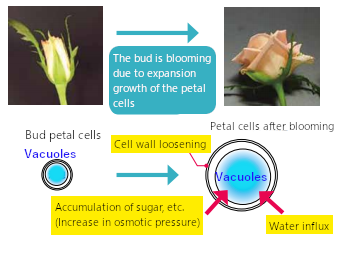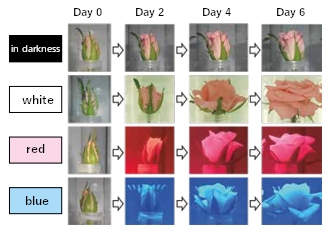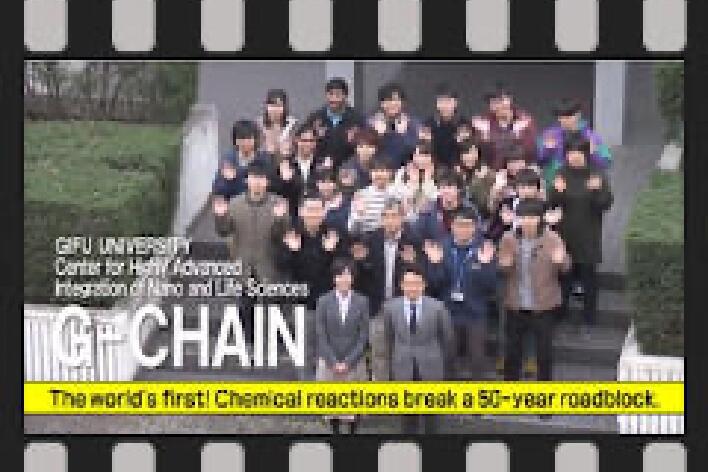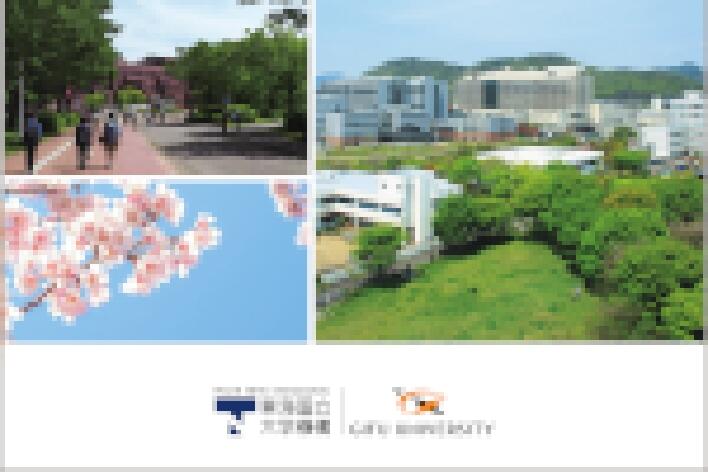Cut roses can bloom even more fully! We are drawing out capacities hidden within these plants to improve their value as agricultural products.
*Information related to faculty members/students and graduate schools at Gifu University here are all that of the time of interviewing.

The key to getting bigger blooms is found in the methods for managing sugar metabolism.
When they hear the word "bouquet," most people would perhaps think of roses. The rose is such an important flower, but it has many challenges, such as withering due to heat; it is also a flower highly deserving of research. I began studying roses about 20 years ago. When I worked as a postdoctoral fellow at a laboratory in the Ministry of Agriculture, Forestry, and Fisheries, my boss specialized in roses, and that is where this research began.
When you buy roses in a store, I believe they come with a chemical agent to maintain freshness. What that substance actually contains is sugar and antimicrobial agents. In my postdoctoral days, my boss was the one who determined that sugar helps cut roses last longer and bloom more fully. Based on that work, I endeavored to explain this mechanism in terms of sugar metabolism and gene expression. The blooming mechanism that was identified was that "as sugar metabolism (conversion) progresses in the petals, the buds swell due to the sugar intake and water influx into the petal cells, causing the flower to bloom" (Figure 1).
Based on the results of that research, I am currently investigating how to make cut roses bloom more, that is, larger blooms. Cut flowers are harvested as buds, and gradually bloom as an ornament, finally reaching full bloom. However, the same state of full bloom is smaller for a cut flower than for a rose on the tree. This is where I thought to draw out the flowers' full blooming capacity to the maximum extent.
The key to getting bigger blooms lies within the blooming mechanism, in how much the petals' sugar metabolism is facilitated. There are two possible methods. The first is to activate an enzyme in the petals called invertase. Unlike flowers on the tree, it becomes clear that cut flowers have weaker invertase activity promoting sugar metabolism. Thus, if we give those cut flowers the plant growth hormone auxin, which stimulates invertase, it may be possible to make the roses bloom more fully. Another method involves the use of light. Light wavelength (the color of the light) affects the growth rate of flowers. For example, roses' blooming speed slows down if the flowers are exposed to red light (Figure 2). Therefore, I hypothesize that light has some kind of relationship with the physiological metabolism of flowers, and that it may be possible to control the speed of blooming using light.
Currently, my work involves giving cut flowers auxin and light in addition to sugar and analyzing the chronological changes to the flower's gene expression, enzyme activity, and sugar composition involved in the sugar metabolism as they bloom. However, it is not so simple to solve the issue with just one element. For example, if the plant is exposed to light, photosynthesis occurs in the leaves, producing sugar sucrose, but the majority of that sucrose remains in the leaves and never reaches the petals. If we put too much auxin or sugar in the vase water, the majority of it will accumulate in the leaves, and harmful side effects can occur. Therefore, rather than putting it in the vase water, I believe I will have to use a comprehensive approach and develop new methods, such as spraying a mist of auxin directly onto the petals.
|
Figure 1. Rose Blooming Mechanism  The rose blooming mechanism as clarified in this study. As sugar metabolism (conversion) progresses in the petals, sugars are drawn into the petal cells and accumulates there. Then, with the influx of water as osmotic pressure increases and the cell walls loosen, the cells undergo expansion growth, and the flower blooms. |
Figure 2. The Relationship Between Light Wavelength (Color) and Blooming Speed  It was discovered that rose blooming speed changes depending on light wavelength. Based on this, it is thought that light wavelength is related to the physiological metabolism of flower petals. Since blooming speed drops under red LED lights in particular, we might expect that these could be used to suppress blooming during transport and storage. |
"Usefulness in industry" is the mission of the agricultural researcher.

My current research objective is "bigger blooms," but my previous objective was to make cut flowers "last longer." I thought that if there were a longer period between when the flower is put into a vase and when it blooms, consumer satisfaction would increase as they would be able to enjoy the flower for longer. However, there is still the possibility that the flower will wither before reaching full bloom. Previously, in my conversations with growers in the major rose production areas of Ono Town and Mizuho City in Gifu Prefecture, I was told that "Even if the flowers bloom more quickly, consumers would be more satisfied by getting a more reliably larger bloom, which might incentivize them to purchase more flowers." That is when I took another good look at my research and decided on my current objective.
"Agricultural research is for industry. It is not research for the sake of research." These are the words of Professor Hirokazu Fukui, the vice president of Gifu University, and previous head of the horticulture laboratory. The mission of an agricultural researcher is to submit results that are useful to the industry. To this end, we must "know the site to discover the issues," "explain mechanisms scientifically," and ask, "how will this be used?" In an effort to not fail to achieve any of them, I am always strongly aware of these three steps.
If it becomes possible to get cut roses to bloom more fully, not only will consumers be more satisfied, but it may also be possible to improve the value of roses even further by reducing damages in transit by being able to harvest and ship roses when their buds are still small. Going forward, I will continue my research with the goal of establishing techniques that will delight both consumers and producers.





